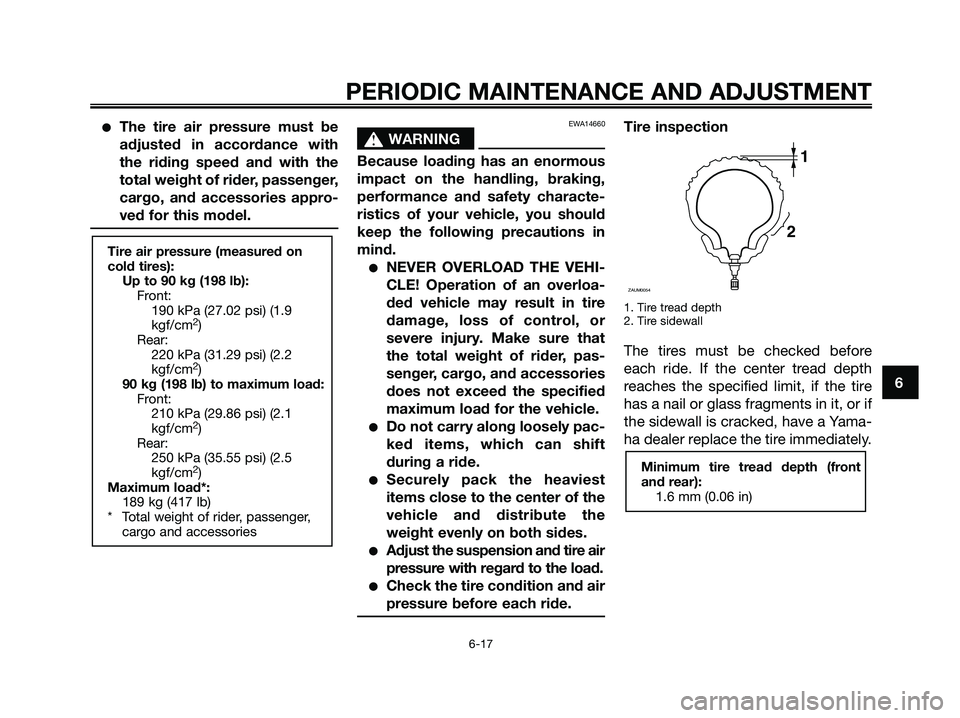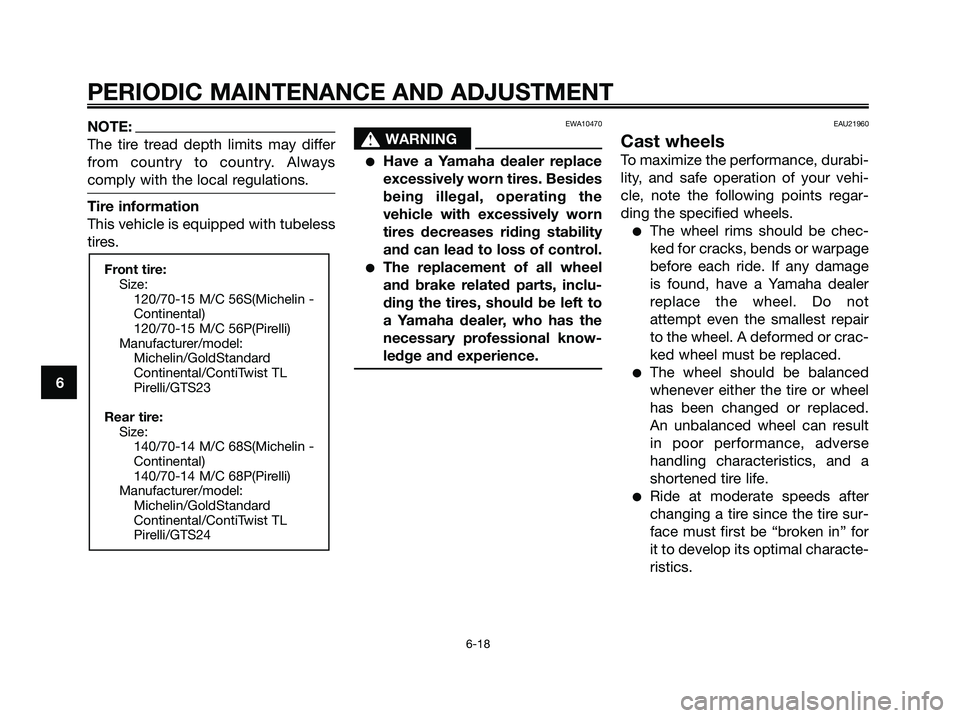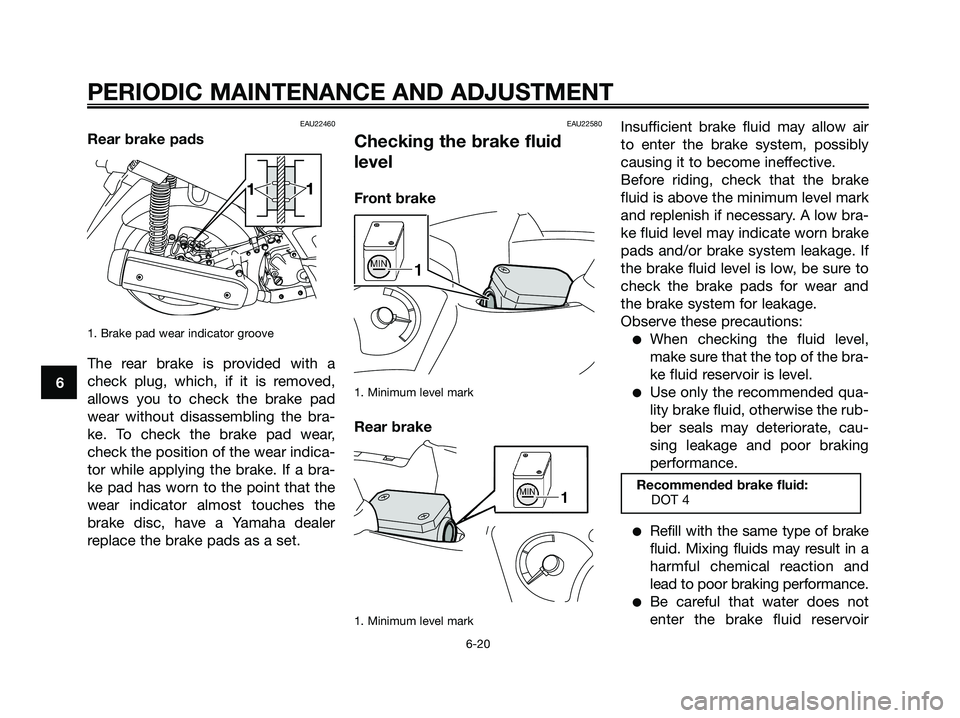Page 56 of 92

5. Close the reservoir cap
6. Place the floorboard mat in the
original position and push it
downward to secure it.
EAU33031
Changing the coolant
The coolant must be changed at the
intervals specified in the periodic
maintenance and lubrication chart.
Have a Yamaha dealer change the
coolant. WARNING! Never attempt
to remove the radiator cap when
the engine is hot.
[EWA10381]EAUM2242
Air filter and V-belt case air
filter elements
The air filter element should be repla-
ced and the V-belt case air filter ele-
ment should be cleaned at the inter-
vals specified in the periodic
maintenance and lubrication chart.
Service the air filter elements more
frequently if you are riding in unu-
sually wet or dusty areas.
Replacing the air filter element
1. Place the scooter on the centers-
tand.
1. Air filter case cover
2. Screw
3. Air filter element
2. Remove the air filter case cover
by removing the screws.
1. Air filter element
3. Pull the air filter element out.
4. Insert a new air filter element into
the air filter case.
5. Install the air filter case cover by
installing the screws.
Cleaning the V-belt case air filter
element
1. Remove cowling C. (See page
6-6).
2. Remove the V-belt case air filter
covers by removing the screws.
1
2 2
ZAUM06623
PERIODIC MAINTENANCE AND ADJUSTMENT
6-14
6
1B9-F8199-E3.QXD 21/10/08 13:43 Página 56
Page 57 of 92

1. V-belt case air filter cover
2. Screw
1. Screw
2. V-belt case air filter cover
3. Remove the air filter element, and
then blow out the dirt with com-
pressed air as shown.
1. V-belt case air filter element
4. Check the air filter element for
damage and replace it if neces-
sary.
5. Install the air filter element with
the colored side facing outward.
6. Install the V-belt case air filter
covers by installing the screws.
NOTICE: Make sure that each
filter element is properly sea-
ted in its case. The engine
should never be operated wit-
hout the filter elements insta-
lled, otherwise the piston(s)
and/or cylinder(s) may become
excessively worn.
[ECA10531]
7. Install the cowling.
EAUS1290
Adjusting the throttle cable
free play
1. Throttle cable free play
The throttle cable free play should
measure 3.0 -5.0 mm (0.12 -0.20 in) at
the throttle grip. Periodically check
the throttle cable free play and, if
necessary, adjust it as follows.
TIP
The engine idling speed must be
correctly adjusted before checking
and adjusting the throttle cable free
play.
1. Remove cowling A (See page
6-6).
2. Loosen the locknut.
1
ZAUM0706
1
2
ZAUM0705
2 1ZAUM0704
PERIODIC MAINTENANCE AND ADJUSTMENT
6-15
6
1B9-F8199-E3.QXD 21/10/08 13:43 Página 57
Page 58 of 92

3. To increase the throttle cable free
play, turn the adjusting nut in
direction (a). To decrease the
throttle cable free play, turn the
adjusting nut in direction (b).
1. Rubber cap
2. Locknut
3. Adjusting nut
4. Tighten the locknut.
5. Install the cowling.
EAU21401
Valve clearance
The valve clearance changes with
use, resulting in improper air-fuel mix-
ture and/or engine noise. To prevent
this from occurring, the valve clearan-
ce must be adjusted by a Yamaha
dealer at the intervals specified in the
periodic maintenance and lubrication
chart.
EAU21871
Tires
To maximize the performance, durabi-
lity, and safe operation of your vehi-
cle, note the following points regar-
ding the specified tires.
Tire air pressure
The tire air pressure should be chec-
ked and, if necessary, adjusted befo-
re each ride.
EWA10500
s s
WARNING
●The tire air pressure must be
checked and adjusted on cold
tires (i.e., when the temperatu-
re of the tires equals the
ambient temperature).
ZAUM0053
PERIODIC MAINTENANCE AND ADJUSTMENT
6-16
6
1B9-F8199-E3.QXD 21/10/08 13:43 Página 58
Page 59 of 92

●The tire air pressure must be
adjusted in accordance with
the riding speed and with the
total weight of rider, passenger,
cargo, and accessories appro-
ved for this model.EWA14660
s s
WARNING
Because loading has an enormous
impact on the handling, braking,
performance and safety characte-
ristics of your vehicle, you should
keep the following precautions in
mind.
●NEVER OVERLOAD THE VEHI-
CLE! Operation of an overloa-
ded vehicle may result in tire
damage, loss of control, or
severe injury. Make sure that
the total weight of rider, pas-
senger, cargo, and accessories
does not exceed the specified
maximum load for the vehicle.
●Do not carry along loosely pac-
ked items, which can shift
during a ride.
●Securely pack the heaviest
items close to the center of the
vehicle and distribute the
weight evenly on both sides.
●Adjust the suspension and tire air
pressure with regard to the load.
●Check the tire condition and air
pressure before each ride.
Tire inspection
1. Tire tread depth
2. Tire sidewall
The tires must be checked before
each ride. If the center tread depth
reaches the specified limit, if the tire
has a nail or glass fragments in it, or if
the sidewall is cracked, have a Yama-
ha dealer replace the tire immediately.
Minimum tire tread depth (front
and rear):
1.6 mm (0.06 in)
1
2
ZAUM0054
Tire air pressure (measured on
cold tires):
Up to 90 kg (198 lb):
Front:
190 kPa (27.02 psi) (1.9
kgf/cm
2)
Rear:
220 kPa (31.29 psi) (2.2
kgf/cm
2)
90 kg (198 lb) to maximum load:
Front:
210 kPa (29.86 psi) (2.1
kgf/cm
2)
Rear:
250 kPa (35.55 psi) (2.5
kgf/cm
2)
Maximum load*:
189 kg (417 lb)
* Total weight of rider, passenger,
cargo and accessories
PERIODIC MAINTENANCE AND ADJUSTMENT
6-17
6
1B9-F8199-E3.QXD 21/10/08 13:43 Página 59
Page 60 of 92

NOTE:
The tire tread depth limits may differ
from country to country. Always
comply with the local regulations.
Tire information
This vehicle is equipped with tubeless
tires.
EWA10470
s s
WARNING
●Have a Yamaha dealer replace
excessively worn tires. Besides
being illegal, operating the
vehicle with excessively worn
tires decreases riding stability
and can lead to loss of control.
●The replacement of all wheel
and brake related parts, inclu-
ding the tires, should be left to
a Yamaha dealer, who has the
necessary professional know-
ledge and experience.
EAU21960
Cast wheels
To maximize the performance, durabi-
lity, and safe operation of your vehi-
cle, note the following points regar-
ding the specified wheels.
●The wheel rims should be chec-
ked for cracks, bends or warpage
before each ride. If any damage
is found, have a Yamaha dealer
replace the wheel. Do not
attempt even the smallest repair
to the wheel. A deformed or crac-
ked wheel must be replaced.
●The wheel should be balanced
whenever either the tire or wheel
has been changed or replaced.
An unbalanced wheel can result
in poor performance, adverse
handling characteristics, and a
shortened tire life.
●Ride at moderate speeds after
changing a tire since the tire sur-
face must first be “broken in” for
it to develop its optimal characte-
ristics.
Front tire:
Size:
120/70-15 M/C 56S(Michelin -
Continental)
120/70-15 M/C 56P(Pirelli)
Manufacturer/model:
Michelin/GoldStandard
Continental/ContiTwist TL
Pirelli/GTS23
Rear tire:
Size:
140/70-14 M/C 68S(Michelin -
Continental)
140/70-14 M/C 68P(Pirelli)
Manufacturer/model:
Michelin/GoldStandard
Continental/ContiTwist TL
Pirelli/GTS24
PERIODIC MAINTENANCE AND ADJUSTMENT
6-18
6
1B9-F8199-E3.QXD 21/10/08 13:43 Página 60
Page 61 of 92

EAU33453
Front and rear brake lever
free play
Front
RearThere should be no free play at the
brake lever ends. If there is free play,
have a Yamaha dealer inspect the
brake system.EWA14211
s s
WARNING
A soft or spongy feeling in the bra-
ke lever can indicate the presence
of air in the hydraulic system. If the-
re is air in the hydraulic system,
have a Yamaha dealer bleed the
system before operating the vehi-
cle. Air in the hydraulic system will
diminish the braking performance,
which may result in loss of control
and an accident.
EAU22390
Checking the front and rear
brake pads
The front and rear brake pads must
be checked for wear at the intervals
specified in the periodic maintenance
and lubrication chart.
EAU22400
Front brake pads
1. Lining thickness
Check each front brake pad for
damage and measure the lining thick-
ness. If a brake pad is damaged or if
the lining thickness is less than 0.5
mm (0.02 in), have a Yamaha dealer
replace the brake pads as a set.
PERIODIC MAINTENANCE AND ADJUSTMENT
6-19
6
1B9-F8199-E3.QXD 21/10/08 13:43 Página 61
Page 62 of 92

EAU22460
Rear brake pads
1. Brake pad wear indicator groove
The rear brake is provided with a
check plug, which, if it is removed,
allows you to check the brake pad
wear without disassembling the bra-
ke. To check the brake pad wear,
check the position of the wear indica-
tor while applying the brake. If a bra-
ke pad has worn to the point that the
wear indicator almost touches the
brake disc, have a Yamaha dealer
replace the brake pads as a set.
EAU22580
Checking the brake fluid
level
Front brake
1. Minimum level mark
Rear brake
1. Minimum level mark
Insufficient brake fluid may allow air
to enter the brake system, possibly
causing it to become ineffective.
Before riding, check that the brake
fluid is above the minimum level mark
and replenish if necessary. A low bra-
ke fluid level may indicate worn brake
pads and/or brake system leakage. If
the brake fluid level is low, be sure to
check the brake pads for wear and
the brake system for leakage.
Observe these precautions:
●When checking the fluid level,
make sure that the top of the bra-
ke fluid reservoir is level.
●Use only the recommended qua-
lity brake fluid, otherwise the rub-
ber seals may deteriorate, cau-
sing leakage and poor braking
performance.
●Refill with the same type of brake
fluid. Mixing fluids may result in a
harmful chemical reaction and
lead to poor braking performance.
●Be careful that water does not
enter the brake fluid reservoir
Recommended brake fluid:
DOT 4
PERIODIC MAINTENANCE AND ADJUSTMENT
6-20
6
1B9-F8199-E3.QXD 21/10/08 13:43 Página 62
Page 63 of 92

when refilling. Water will signifi-
cantly lower the boiling point of
the fluid and may result in vapor
lock.
●Brake fluid may deteriorate pain-
ted surfaces or plastic parts.
Always clean up spilled fluid
immediately.
●As the brake pads wear, it is nor-
mal for the brake fluid level to
gradually go down. However, if
the brake fluid level goes down
suddenly, have a Yamaha dealer
check the cause.
EAU22721
Changing the brake fluid
Have a Yamaha dealer change the
brake fluid at the intervals specified in
the TIP after the periodic maintenan-
ce and lubrication chart. In addition,
have the oil seals of the brake master
cylinder and caliper as well as the
brake hose replaced at the intervals
listed below or whenever they are
damaged or leaking.
●Oil seals: Replace every two
years.
●Brake hose: Replace every four
years.
EAU23101
Checking and lubricating the
cables
The operation of all control cables
and the condition of the cables
should be checked before each ride,
and the cables and cable ends should
be lubricated if necessary. If a cable is
damaged or does not move smoothly,
have a Yamaha dealer check or repla-
ce it. WARNING! Damage to the
outer sheath may interfere with
proper cable operation and will
cause the inner cable to rust.
Replace a damaged cable as soon
as possible to prevent unsafe con-
ditions.
[EWA10721]
Recommended lubricant:
Engine oil
PERIODIC MAINTENANCE AND ADJUSTMENT
6-21
6
1B9-F8199-E3.QXD 21/10/08 13:43 Página 63